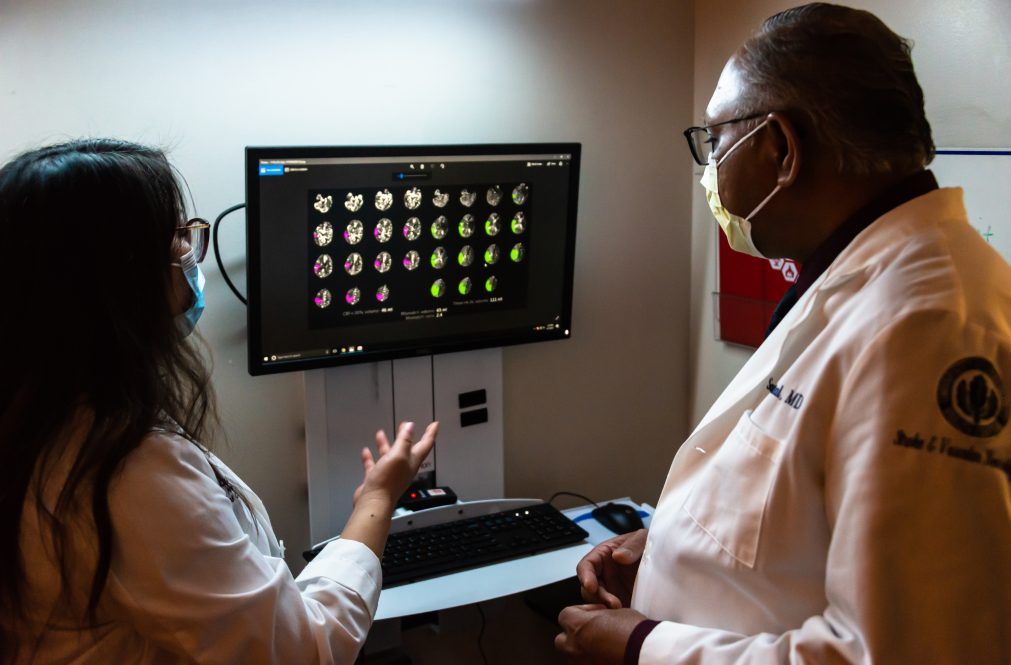It may not be on everyone’s radar that COVID can cause a vasculitis in the brain, which also can cause strokes. — Dr. Gracia Mui
While the theory of a connection between severe COVID-19 and stroke risk goes back to 2020, what may be lesser known is UConn Health’s role in establishing that connection.
A patient encounter during one of the pandemic’s early waves yielded some of the first evidence in the world that would provide validation of what the medical community was beginning to suspect, as UConn Health researchers describe in a commentary recently published in the journal Operative Neurosurgery.

“We have a brain biopsy from someone proving that COVID can affect the blood vessels in the brain, which could lead to strokes,” says Dr. Gracia Mui, co-director of the UConn Health Stroke Center and the commentary’s co-author.
It didn’t take long for doctors and nurses to notice blood clots in people hospitalized with severe COVID-19.
“Especially when we were putting lines in, we noticed that they would clot very easily,” Mui says. “They were also having incidental strokes. A lot of times as they were coming off the ventilators we’d notice that they had a small stroke or a big stroke.”
COVID-19 has been found to make people hypercoagulable, or more at risk of having blood clots. A majority of strokes are ischemic strokes, caused by blocked blood vessels to the brain.
But another, less-apparent path from COVID-19 to stroke is vasculitis, or inflammation of the blood vessels, in the central nervous system. The pathology of a tissue biopsy from one of those early cases at UConn Health provided scientific evidence of that association.

In their commentary, Mui and co-authors Shriya Gupta (Department of Neurology), Dr. Erica Becker (Department of Internal Medicine), Aziz Khan (Department of Internal Medicine), Dr. Ketan Bulsara (Division of Neurosurgery chief), and Dr. Qian Wu (Department of Pathology and Laboratory Medicine) refer to the case of a woman in her 50s who had suffered a stroke and was brought to the emergency department. She had had COVID-19, was symptomatic, and had several comorbidities. Investigation through imaging and a brain biopsy revealed several irregularities consistent with vasculitis. Her neurological symptoms showed improvement over the course of several weeks of treatment.
“It may not be on everyone’s radar that COVID can cause a vasculitis in the brain, which also can cause strokes,” Mui says.
“The passage of time continues to reveal novel manifestations of SARS-CoV-2,” the authors conclude. “In many ways, we may only be seeing the beginning of some of the [central nervous system] manifestations.”
The message remains to watch for signs of stroke in those who have severe COVID-19, even those who are younger and otherwise don’t fit the traditional profile for stroke risk (such as high blood pressure, high cholesterol, heart disease, diabetes, or obesity). Experts recommend using the acronym BE FAST to help recognize stroke’s warning signs:
- B – BALANCE: Watch for sudden loss of balance
- E – EYES: Check for vision loss
- F – FACE: Does one side of the face droop or is it numb? Ask the person to smile. Is the person’s smile uneven?
- A – ARM: Is one arm weak or numb? Ask the person to raise both arms. Does one arm drift downward?
- S – SPEECH: Is speech slurred? Is the person unable to speak or hard to understand? Ask the person to repeat a simple sentence, like “The sky is blue.” Is the sentence repeated correctly?
- T – TIME: If someone shows any of these symptoms, even if the symptoms go away, call 9-1-1 and get the person to the hospital immediately. Check the time so you’ll know when the first symptoms appeared.
The current consensus is the elevated stroke risk subsides a month after COVID-19 infection. It’s not known yet whether a subsequent infection with a different variant resets that risk.



